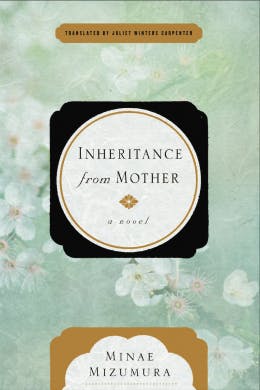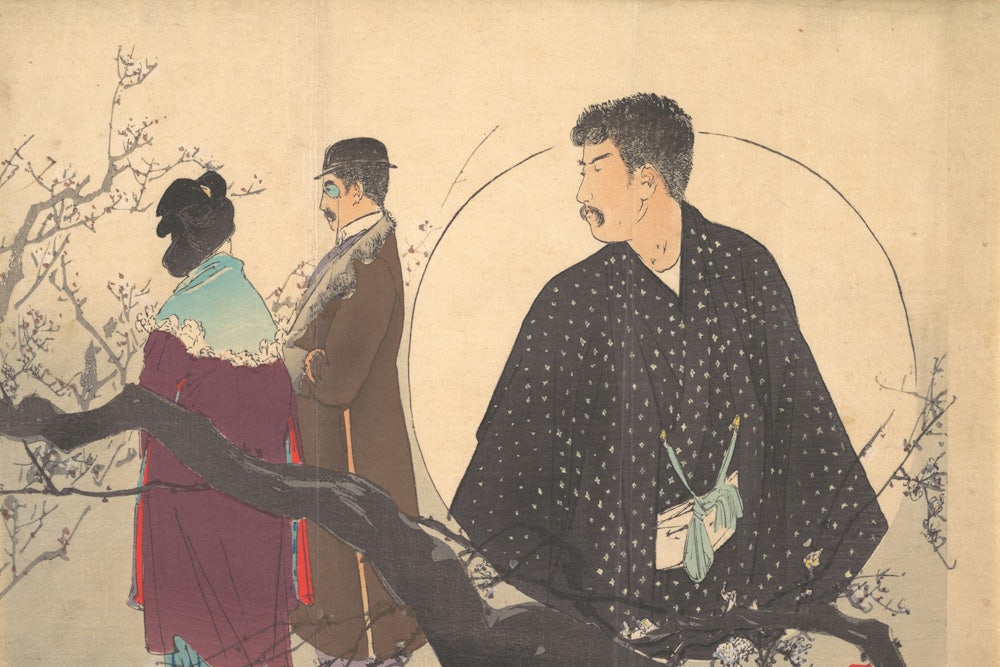
The Japanese have long obsessed over the ideal way to die. “Think constantly of your death!” the samurai Masahige is said to have told his son in 1336, shortly before committing ritual suicide. Dying well, dying with honor, dying on one’s own terms—these were of paramount importance, for to die badly was to make a travesty of one’s life. For kamikaze pilots in World War II, death was, in fact, life’s epitome: the ultimate expression of valor and selflessness. The pilots compared themselves to that ancient Japanese symbol of evanescent beauty, the cherry blossom; as one 22-year-old pilot wrote, in haiku: “If only we might fall/Like cherry blossoms in the spring—/So pure and radiant!” Yukio Mishima, the great Japanese novelist of the postwar era, saw a brilliant demise as the apotheosis of artistic genius. “Let me live like a sky-rocket,” the adolescent Mishima wrote. “Let me color the night sky for an instant with all my being and then burn out.”
The irony is that Japan has turned into the oldest population in the world, with millions of people occupying an in-between state: not dead yet, but not quite alive anymore either. They scud through their days on a cloud of medication. They need assistance to walk, to eat, to go to the toilet. When they fall—and they always fall—their bones break like twigs. When a fog shrouds their minds, they struggle to recognize the faces of their children. Some of them spend their last months, their last years even, prone on a hospital bed, their slack mouths agape, their bodies fed a slurry through tubes. The gift of long life has turned into a curse; as Minae Mizumura writes in her new novel, Inheritance From Mother, the Japanese “lived longer every year, lingering like specters.”
There is little dignity in the way the Japanese die now. Worse still, this indignity is what the elderly pass on to their descendants, weighing their lives down with medical bills and mental torment. Who wouldn’t secretly want their ailing parent to give up the ghost?
This is the central dilemma facing Mizumura’s middle-aged protagonist, Mitsuki Katsura, a part-time French-language instructor and translator in Tokyo. Like Camus’s The Stranger, whose famous opening line—“Today, Maman died”—is repeated like a choral incantation throughout the novel, Inheritance From Mother begins with a mother’s death. In The Stranger, Meursault’s laconic response is meant to reflect a matter-of-fact indifference. For Mitsuki, Camus’s words echo with a relief approaching glee: “Even after returning home, Mitsuki had remained exhilarated, knowing that her mother was finally dead.”
What follows is a narrative that describes how Mitsuki reached this low point. She is obliged to tally the inheritance, both literal and figurative, her “monster mother” has bequeathed to her. In doing so she must go beyond the peculiarities of their troubled relationship, beyond the grinding toll that a prolonged hospitalization can take on even the strongest family bonds, to construct a story whose distinct layers, like lacquer, are laid over one another to form a lustrous whole. In Inheritance From Mother, the lines between past and present blur; the East is transposed like a palimpsest over West; and life shades into literature.
If Mitsuki’s mother Noriko is a monster—selfish, shallow, overbearing—then this is partly due to forces outside her control. Noriko is born out of wedlock, to a former geisha who, inspired by a popular 19th-century serial novel called The Golden Demon, left her wealthy husband for a mere tutor. Impoverished and illegitimate, Noriko grows up in pre-war Japan obsessed with visions of a better life, an exercise in castle-building that is shot through with dreams of the West. Out of tattered yukatas—the thin cotton garments the Japanese wear after taking a bath—she sews makeshift versions of the elaborate gowns she sees in foreign films: “When night came on, she would lay out her thin mattress next to her mother’s on the frayed tatami and drift off to sleep amid the ratty furniture, clad in a homemade ball gown.”
Noriko lives in several overlapping worlds at once. She is infatuated not only with American movie stars and the life of the silver screen, but also with a group of upper-class relatives on her mother’s side who are rich and cultured; several of them are professional classical musicians. The denizens of this rarefied echelon—what Noriko calls “Yokohama,” after a port city historically considered Japan’s gateway to the West—form a kind of aristocracy by virtue of their familiarity with Western ways: they play the piano, they go to the opera, they sit on sofas, they read English books. Like an upstart in a Victorian novel, Noriko longs to supersede her own lowly station and pass into this world—and partially succeeds, by marrying her daughter, Mitsuki’s more beautiful and talented sister, Natsuki, to a young member of the Yokohama clan.
This sets the pattern of Mitsuki’s relationship with Noriko. Mitsuki is the plain sister, doomed to be taken for granted by her starstruck mother. Even decades later, when Noriko begins her descent into infirmity, it is Mitsuki who is expected to take care of her, not the rich, pampered Natsuki.
Mitsuki herself is also vulnerable to the West’s bewitchment—in Mizumura’s universe, everyone in Japan is under its spell—but her poison of choice is the novel. She travels to Paris for a year to study, and there she meets Tetsuo, an aspiring intellectual of humble means who has landed in Paris on a prestigious scholarship. In Mitsuki’s eyes there is something impossibly romantic about this figure. He may reside in a dingy attic up six flights of stairs, but in her imagination he leads a more exalted existence, known to dilettantes and artists alike as the life of the mind. “The Tetsuo who had sat amid the flickering candlelight in the garret in Paris, looking grave—how many different heroes she had happily projected onto him!” These include Julian Sorel of The Red and the Black, Heathcliff of Wuthering Heights, and Kan’ichi, the tutor from The Golden Demon: “Young men who were penniless but reaching for the stars, longing to rise above life’s vulgarity, and passionately in love with one woman.” Reader, she marries him—and many years later, when her mother is dying, he is off in Vietnam with a younger woman.
Mitsuki’s twin crises—the failure of her marriage and her damaged relationship with her mother—are born from something akin to a national crisis. Mizumura is saying that these are the everyday, generational consequences of living in a country that, beginning in the Meiji era, borrowed incessantly from the West in an attempt to modernize. Fashion, infrastructure, weapons, architecture, books, music—all were imported wholesale and absorbed, much as religion, art, and language were appropriated from China in previous centuries. The flood of Western influences included those that were all the more powerful for being internal: notions of beauty, sensibilities, ways of looking at the world. The Japanese themselves would find it hard to parse what part of their psychological makeup is Western in origin. In a revelatory scene, Mitsuki discovers that The Golden Demon, which played such an outsized role in her family’s fate, and, in Mizumura’s telling, transformed a generation of Japanese women into Emma Bovary-like romantics, was actually based on a dime-store novel from America. “She herself was the offspring of a serial novel,” Mitsuki realizes, a blend of East and West.
This intricate weaving is typical of Mizumura, whose last novel translated into English, 2013’s A True Novel, was a brilliant retelling of Wuthering Heights set in postwar Japan. Unlike, say, Yukio Mishima, who would ultimately take mental flight into a militant, hyper-romantic Japanese past (he staged an elaborate ritual suicide that ended in almost farcical fashion), Mizumura has embraced the complex embroidery of Japan’s modern history. In fact, she can’t help but add a postmodern embellishment or two: Inheritance From Mother, like The Golden Demon, was originally published in serial form in a newspaper, as an homage to a “dying tradition.”
Still, the idea that a “hideous modernity” has somehow defiled Japan, to the point that the country no longer knows itself, is a constant source of lament. It is evident in the country’s gray and neon cityscapes: “For all she could tell this might as easily be Seoul or Taipei. Before her there was only barrenness and bleakness—a scene totally without identity.” It suffuses Mitsuki’s own life, which is plagued by “a sense of wrongness,” the feeling “that it wasn’t supposed to turn out this way.” Most of all, it can be felt in Noriko’s long denouement, from nursing home to hospitalization to death.
In The Notebooks of Malte Laurids Brigge, Rilke bemoaned what modernity had done to death. Hospitalization and advances in medical science had stripped death—and thereby life—of its individuality: “you die one of the deaths available at the institution, and are approved accordingly.” These banal deaths could not compare to that of the protagonist’s grandfather, which, according to family lore, was an “evil, regal” death that shook the house and the surrounding countryside. He “would have given short shrift to anyone who had suggested he die some other death rather than this one. He died his terrible death.” Mizumura alludes to a similarly terrible yet noble death, that of a character in the ancient epic The Tale of the Heike, who suffered from “a fever so high that when cold water was poured on him it ‘burst into flames, filling the chamber with thick black smoke and whirling fire.’”
This is contrasted with the image of an elderly Japanese man “lying inert with tubes down his nose.” These deaths are terrible in a completely different way, defined by humiliation and helplessness, rather than a volcanic encounter with destiny. Mizumura goes into clinical detail to show the extent of Noriko’s suffering; a scene with a feeding tube, for example, features dried sputum being constantly removed from the mouth, and subsequently her two front teeth, all while Noriko’s skeletal arms flail weakly in protest. There is much, much more where that came from, a veritable catalogue of mortifying medical conditions and procedures.
To reclaim one’s individuality, as well as one’s agency—this is Mitsuki’s odyssey in the second half of the book. After Noriko has finally died, Mitsuki takes a well-earned vacation in the Japanese countryside. As the train speeds away from her life in Tokyo, it is almost as if Mitsuki is moving back in time, into history, into the myth of the real Japan. (Mizumura, true to form, quickly complicates this notion: Mitsuki’s hotel is modeled on a Swiss chalet, where in the old days “everything was in the style of ‘Over There.’”) During her respite, she decides to divorce her adulterous husband. She begins to piece together a plan, using the money Noriko has left her, to live out her days on her own. She reads a lot of Madame Bovary, and toys with the idea of fulfilling a long-abandoned dream of translating it herself.
We begin, then, to see the shape of her true inheritance: independence, however late it has come. Paradoxically, it is earned by accepting that translation is an essential part of the Japanese condition, not a cruel twist of history to be mourned. Mizumura ends by evoking those cherry blossoms, but this time they signify life, not death.
